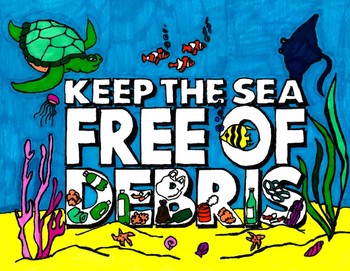 Artwork by Carson M. (Grade 5, Georgia), winner of the Annual NOAA Marine Debris Program Art Contest.
The season of gratitude is here!
Thank you to the many of you who have responded to our survey! We've started to make changes, and are looking forward to rolling out more improvements based on feedback. To start, several people requested that activity age bands be more prominent, so here we've organized this edition's resources by the best-fit age for that activity.
For Elementary School:
- NOAA Marine Debris Art Contest Now Open
- Ocean Odyssey Educators Guide
For Middle School:
- NOAA Marine Debris Art Contest Now Open
- In the Classroom: Planet Stewards Featured in The Earth Scientist
- Student Opportunity: NOAA Ocean Guardian Youth Ambassador Program
For High School and Older:
- In the Classroom: Guam Ocean Guardians in Action
- In the Classroom: Planet Stewards Featured in The Earth Scientist
- Student Opportunity: NOAA Ocean Guardian Youth Ambassador Program
- Student Opportunities: Fellowships, Scholarships, & Internships, Oh My!
This edition's featured activity is also a bit different, and focuses on bringing the art contest into the classroom!
Enthusiastically,
Alexandria Gillen, NOAA Marine Debris Program Education Specialist
![Artwork of a sandy beach with debris and seashells spelling out "Stop Debris, [love] Me".](https://content.govdelivery.com/attachments/fancy_images/USNOAANOS/2022/11/6698067/4420793/2-va-ella-k_crop.jpg) Artwork by Ella K. (Grade 2, Virginia), winner of the Annual NOAA Marine Debris Program Art Contest.
Are you a student or teacher who’s passionate about marine debris? Then get your art supplies ready, because this year’s NOAA Marine Debris Program Art Contest is officially open! Students in grades K-8 from the United States and U.S. territories can submit their artwork now through December 16th. Winning artwork will be featured in our 2024 Marine Debris Calendar!
Check out the Featured Activity in this newsletter to see some tips and tricks for bringing the art contest to life in your learning environment. Plus, you can download the 2023 Marine Debris Calendar on our website now!
Learn more
Best for: Elementary School, Middle School, Informal Audiences
Applicable Region(s): All U.S. states and territories
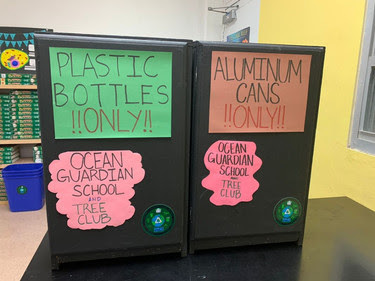 Recycling bins for plastic bottles and aluminum cans are implemented by the NOAA Ocean Guardian School Program and TREE Club at Simon Sanchez High School (Credit: J. Anitok).
Check out this guest blog, written by a student at Simon A. Sanchez High School, who is working to reduce marine debris through the Ocean Guardian School project!
With its crystal clear waters and rich coral reefs, Guam is undoubtedly a hidden paradise in the Pacific ocean. It is home to five protected marine preserves teeming with aquatic animals and plants. Everything on the island is connected, from the mountain ridges to the lively reefs, meaning that even the tiniest actions can offset the entire ecosystem. The Ocean Guardian School project at Simon A. Sanchez High School worked together with five other schools across the island to minimize impacts on the ecosystem and reduce potential sources of marine debris.
Learn more
Best for: High School
Applicable Region(s): Pacific Islands
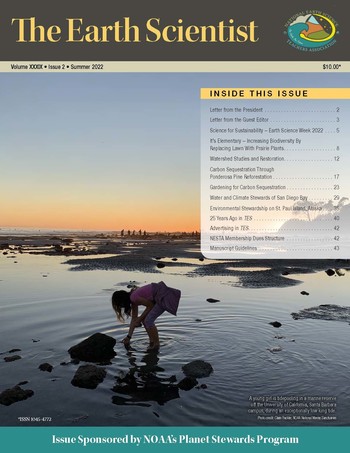 Six NOAA Planet Stewards educators and their projects are featured in the latest issue of The Earth Scientist, including two focused on marine debris (Credit: The Nattional Earth Science Teachers Association).
The National Earth Science Teachers Association's latest edition of The Earth Scientist is out! This issue features six articles written by NOAA Planet Stewards Educators about the projects they carried out within their schools and communities, including two projects participating in marine debris removal, awareness, and prevention in Alaska and California.
All educator projects are aligned to the Next Generation Science Standards, and their articles have links to activities and lessons they carried out. We hope you’ll enjoy this issue and be inspired to take action in your communities.
Learn more
Best for: Middle School, High School
Applicable Region(s): Alaska, California
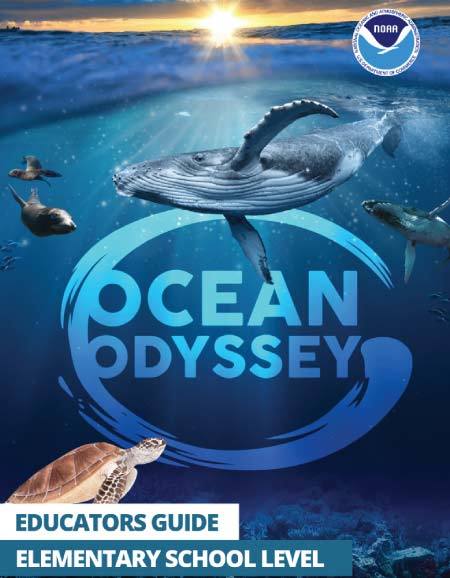 The Ocean Odyssey Educators Guide features eight elementary school lessons inspired by topics from the IMAX film Ocean Odyssey (Credit: NOAA).
NOAA Ocean Service Education, in partnership with K2 Studios, has developed a series of eight elementary school level lesson plans inspired by the IMAX film Ocean Odyssey. The lessons present many NOAA mission critical areas including: ocean biodiversity, marine mammal ecology and migration, ocean currents and climate, sustainable fishing, and marine debris. Watching the film is not required to carry out any of the lessons. Educators and their students can view a special extended preview of the film here.
Check out Lesson 7 - Food Matters to learn about how microplastics can impact marine food webs through ingestion!
Learn more about the National Ocean Service Ocean Odyssey Educators Guide
Learn more about how marine debris impacts food webs on the Marine Debris Program blog
Best for: Elementary School
Applicable Region(s): All U.S. states and territories
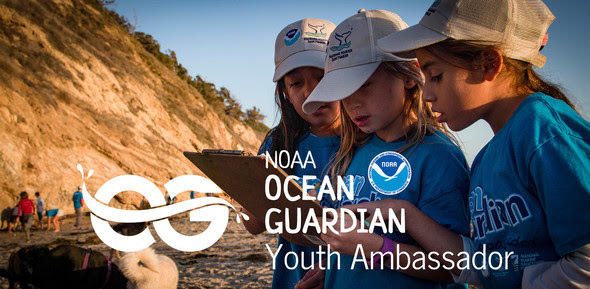 Apply to the new NOAA Ocean Guardian Youth Ambassador Program! (Credit: NOAA).
The NOAA Ocean Guardian Youth Ambassador program provides a new level of engagement for youth aged 12-18 committed to ocean conservation and stewardship of our blue planet. We are looking for enthusiastic youth with new ideas and a unique perspective to learn more about America’s underwater treasures and to share their passion with others. Together we can make a difference in the conservation of the ocean through marine protected areas, and enhanced ocean and climate literacy.
Applications are due January 6, 2023.
Learn more
Best for: Middle School, High School
Applicable Region(s): All U.S. states and territories
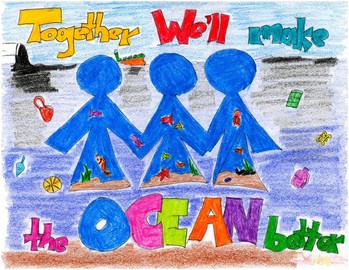 Work together with scientists from NOAA and other Federal agencies in these exciting internship and scholarship opportunities (Artwork by Xhian R., Grade 2, U.S. Virgin Islands).
This fall, a number of exciting opportunities are opening up for post-secondary students (undergraduate and graduate students). While these opportunities vary in their eligible audiences and areas of focus, all represent opportunities for students, especially students from underrepresented and indigenous communities, to work with NOAA scientists or other government mentors.
Future Leaders in Public Service Internship Program
- Summer internships with a Federal agency for undergraduate, graduate and professional students from across disciplines
- Application period closes November 27, 2022
Dr. Nancy Foster Scholarship Program
- Application period closes December 22, 2022
NOAA Undergraduate Scholarships (Hollings Scholarship & José E. Serrano Educational Partnership Program with Minority Serving Institutions)
- Application period closes January 31, 2023
Sea Grant Community-Engaged Internships
- Undergraduate internships available through state Sea Grant programs
- Application periods vary by program
Best for: Post-Secondary students
Applicable Region(s): All U.S. states and territories
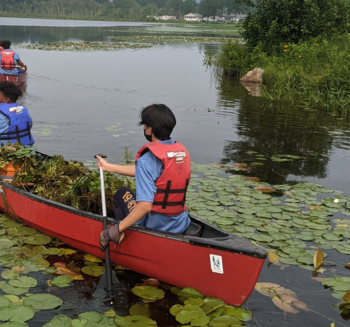 The B-WET program is an environmental education program that promotes place-based experiential learning for K–12 students and related professional development for teachers (Credit: Katherine Scott/HVA Connections, Peggy Stewart/Western Connecticut State University).
Bay Watershed Education and Training (B-WET) funding is provided through competitive grants that promote Meaningful Watershed Educational Experiences (MWEEs). The B-WET program offers regional funding opportunities through local NOAA host offices. Regional funding opportunities are generally published in late summer or fall each year. Several regional opportunities are now available, including the Gulf of Mexico, Hawai'i, and the Chesapeake Bay. Other regional opportunities will likely open soon.
Learn more
Applicable Region(s): Mid-Atlantic, Gulf of Mexico, Hawai'i
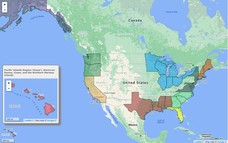
Check out some marine debris projects around the country.
|
 Ocean Guardian School students at John F. Kennedy High School distribute reusable water bottles and bags on campus to promote alternatives to single-use items (Credit: John F. Kennedy High School Ocean Guardian School Program).
Students and teachers at Simon A. Sanchez High School and John F. Kennedy High School in Guam are implementing Ocean Guardian School projects that prevent marine debris and encourage students to lead environmental stewardship in their communities.
Learn more
 Artwork by James S. (Grade 7, Louisiana), winner of the annual NOAA Marine Debris Program Art Contest.
Every year, the NOAA Marine Debris Program coordinates an annual art contest for students in kindergarten through eighth grade to help share the message about the impacts of marine debris and what we can do about it.
Each entry must be composed of a piece of artwork and a description (on the entry form). A NOAA awards panel will collect all entries and select 13 winners to be featured in a marine debris calendar. Entries will be judged on the creativity, artistic presentation, and relevancy to the theme of:
- How marine debris impacts the ocean and the Great Lakes environment.
- What you are doing to help prevent marine debris.
To help you make the most of this opportunity, we've gathered some tips and tricks for getting your students into the creative spirit. Check out our Before, During, and After Activity highlights below!
Before: Introducing the NOAA Marine Debris Program Art Contest
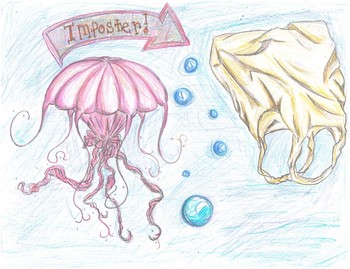 Artwork by Emily B. (Grade 7, Maryland), winner of the annual NOAA Marine Debris Program Art Contest.
Scaffold an effective public awareness and art campaign with "Communicating for a Clean Future" from the lesson collection Turning the Tide on Trash (Grades 8-12)
- This stand-alone lesson is found on page 87 of the curriculum, but you can combine it with other lessons as appropriate for your learning environment.
Mix and match project-based learning lessons and activities from the Oregon Sea Grant's Marine Debris STEAMSS (Science, Technology, Engineering, Art, Math, and Social Studies) curriculum, concluding with the Solutions lesson "Making Connections through Art" (Options for grades 4-12)
- Choose from more than 50 lessons and activities covering marine debris Composition & Abundance, Sources & Transport, Impacts, and Solutions. "Making Connections through Art" is available for grades 4-5, 6-8, and 9-12.
Integrate studying ecosystems and wildlife with marine debris through the Winged Ambassadors classroom activity package (Grades 6-8, with extensions for grades 9-12)
- This 5-lesson unit features standards-aligned, inquiry-based lessons focused on albatrosses, which ingest plastic trash along their migrations. The lesson set concludes with an opportunity to share the messages learned throughout the unit - a perfect opportunity for integrating the art contest!
Combine standards-aligned science lessons with art principles through the Washed Ashore Integrated Arts Marine Debris Curriculum (Grades 5-9)
- While this unit plan is focused on creating mosaic mask sculptures out of recovered debris, the lessons could be easily adapted to create submissions for the art contest.
Informal education groups can coordinate students to reach out to local businesses or other community members to reduce single-use plastics and raise awareness about marine debris with the Trash Shouldn't Splash toolkit
- This toolkit has resources to help students organize their own art contest, but you could also support the community to submit artwork to the NOAA Marine Debris Program contest.
Don't forget to respond to the contest questions!
- How does marine debris impact the ocean and the Great Lakes environment?
- What you are doing to help prevent marine debris?
This is a great opportunity for younger students to practice handwriting. You can attach a separate piece of paper to your entry if the space provided in the entry form is too small!
During: Encouraging Your Artists
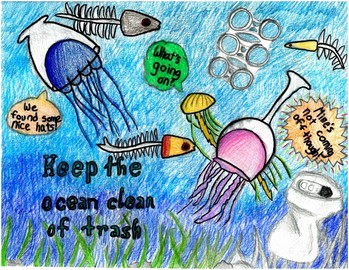 Artwork by Aaron K. (Grade 5, Michigan), winner of the annual NOAA Marine Debris Program Art Contest.
- Is there a story they can tell with their artwork? This might look like comic book panels, incorporating speech bubbles, or featuring memorable characters.
- Can they demonstrate any of the topics they've been learning? Maybe about ecosystems, engineering, or other topics?
- Try using different colors and media like paint, crayon, or colored pencil.
After: From Art to Action!
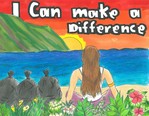
• Celebrate student work by creating an art wall display
• Host a community art show to share learning with others
• Turn artwork into informational posters to help the community reduce single-use plastics (check out inspiration in the Trash Shouldn't Splash toolkit!)
• Compile artwork into a storybook for others to read and learn about marine debris
Artwork by Leilani H. (Grade 8, Hawai'i), winner of the annual NOAA Marine Debris Program Art Contest.
|
 Artwork by Arianna E. (Grade 5, Guam), winner of the annual NOAA Marine Debris Program Art Contest.
While the official NOAA Marine Debris Program art contest is only open to students in Kindergarten through eighth grade in the U.S. states and territories, art is still a great communication tool for students of any age in any location!
Looking for a craft from a previous newsletter? Check out our NOAA Marine Debris Program Newsletter Archive page to revisit all of our past activities.
Interested in more ways to help prevent marine debris at home, at school, or at the store? Dive into all kinds of ideas on our How to Help page.
Have any feedback on our content?
Please complete this survey on the NOAA Marine Debris Program Education Newsletter if you have any questions, ideas, or hopes for our marine debris materials.
Contact us at marinedebris.web@noaa.gov
Subscribe to the NOAA Marine Debris Program Education Newsletter
Subscribe to the NOAA Marine Debris Program Monthly Newsletter
Subscribe to the Marine Debris Blog
|